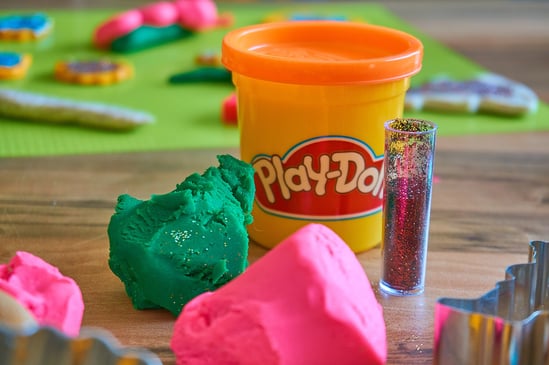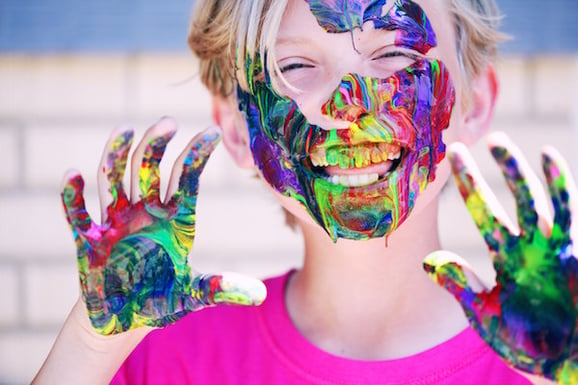
Most of us have played with playdough at some point. Brand name Play-Doh, it's a staple of most childhoods. But what actually is playdough and how is it made? We'll discuss what exactly playdough is and offer some of our favorite recipes and tips on how to make natural DIY playdough right at home.
What Is Playdough?
Playdough is one of those familiar substances that immediately sparks feelings of nostalgia. From it's soft, pliable texture to its distinctive smell, we all think we know playdough. But what exactly is it?
In short, Play-Doh is a modeling compound made primarily from flour, water, salt, borax and mineral oil. Natural recipes have cream of tartar, a white crystalline compound found in baking powder, and can be made with a variety of oils.
Play-Doh is soft and malleable, and can be reused as long as it's stored properly. I'm sure a lot of us remember the disappointment we faced when we came back to our awesome Play-Doh creations to find them dried out and crusty. Proper storage is key with both store bought and homemade playdough.
Where Did Play-Doh Come From?
Play-Doh has come a long way from its origins as a cleaning product, and was even inducted into the National Toy Hall of Fame in 1998. Play-Doh was originally created as a non-toxic, non-staining putty to remove coal stains from wallpaper by Noah and Cleo McVicker of the soap manufacturing company, Kutol Products.
After World War II, the demand for coal-removing putties essentially disappeared. The country turned to natural gas for energy instead of coal, and vinyl wallpaper meant that even when coal was used, it rarely stained.
With its original use obsolete, the makers looked for a new way to market the product in the mid 1950's. Schoolteacher Kay Zufall took the putty to her classroom, and Play-Doh as we know it was born. The creators tweaked the formula, and Zufall named the iconic toy "Play-Doh."
The product re-launched in 1956, with a marketing campaign that consisted of TV spots and in-store demonstrations in retail giants like Macy's. By 1958, the company sold $3 million worth of Play-Doh. Play-Doh is currently owned and manufactured by Hasbro.

Homemade Playdough Recipes
While we love traditional Play-Doh, DIY playdough can be just as fun as playing with it! Keep in mind that homemade playdoughs won't last as long as store-bought Play-Doh, and all playdough should always be put back in a sealed container when not in use.
Most natural recipes contain flour and cream of tartar. We put together a list of recipes with those ingredients, as well as ones without. Remember, store-bought Play-Doh has flour and is not allergy-safe for those allergic to wheat products. Flour-free homemade playdough is a great alternative.
Check out some of our favorite recipes!
Playdough Recipes with Flour and Cream of Tartar
If you're looking to make an edible playdough with easy to find ingredients, check out these two recipes.
What You'll Need:
- Flour
- Water
- Cream of Tartar
- Vegetable Oil
- Food Coloring
The Best Homemade Playdough Recipe from Tinkerlab
Why We Love It: The link above shows the full recipe, and also has a link to a great no-cook playdough recipe in the post. This recipe makes a soft, long lasting playdough and is super easy to follow.
A Simple All-Natural Homemade Playdough Recipe from DIY Natural
Why We Love It: This recipe is all-natural, and can be made with or without cream of tartar. It's one of the more inexpensive recipes, and should last for several months with proper storage.

Flour-Free Playdough Recipes
For playdough with no flour, try one of these easy recipes.
What You'll Need
- Cornstarch
- Baking Soda
- Water
- Oil
- Food Coloring
Allergy-Free Play Dough Recipes from the American Academy of Allergy Asthma and Immunology
Why We Love It: Since wheat allergies are a growing issue amongst kids and adults, the American Academy of Asthma and Immunology put together these fun and helpful recipes for playdough that is both flour-free and edible!
How to Make Playdough Without Flour so You Can Avoid Any & All Playtime Risks from Romper
Why We Love It: This Romper post offers a few recipes for flour-free kids, including a super creative one on how to turn Peeps into playdough. They're fun and creative and allergy-safe.
Cream of Tartar-Free Recipes
These recipes for how to make playdough are the easiest around, requiring no specialty ingredients and little to no cooking.
What You'll Need
- Flour
- Salt
- Water
- Oil
- Food coloring
How to Make Natural Play Dough Without Cream of Tartar from livesimply
Why We Love It: Not only is this recipe cream of tartar-free, but it is definitely one of the quickest recipes on our list, and can be made with items you probably already have at home. It's also (technically) edible, so safe for curious kids.
How To Make Playdough Recipe Without Cream of Tartar from Stay at Home Educator
Why We Love It: This recipe is no cook, which means that you get to dive right in and mix it up with your hands. It's soothing to make and fun to play with when finished!

6 Tips for Making Great Playdough
Whichever recipe you choose—or maybe you'll try them all—making playdough is a blast. Here are some tips to make sure you get the most out of your homemade playdough.
-
Use gel food coloring. It'll help the playdough stay stain-free throughout continued use.
-
Make sure to always store your playdough in an airtight container.
-
You can usually substitute other flours, like almond and coconut, to make wheat-free playdough, if you find that a recipe with flour works best for you but still need it to be wheat-free.
-
Playdough should be cheap and easy to make (which is part of the fun!) so don't get caught up in complicated recipes or expensive ingredients.
-
When picking a recipe, make sure to check how much playdough it makes. You may have to double or triple the recipe to have enough playdough for multiple kids or more than one color.
-
Most recipes allow you to mix in scents too!
Playdough is all about having fun, and making it can be just as exciting as playing with it. It's a great rainy day activity for kids, or fun way for adults to make their own scented stress ball. Unlike playdough itself, making it and playing with it never gets old.
What's Next?
Love making playdough? It's time for slime! Check out our favorite slime recipes.
Educational activities should be fun, too. Luckily, we have 37 kid-friendly science experiments to choose from, and ideas for pipe-cleaner crafts.
And if you're headed outside, learn about the types of clouds!









